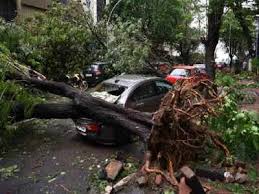Why so many trees fell in Delhi? What experts said.
Why so many trees fell in Delhi? What experts said.
A day after a ‘severe’ category thunderstorm hit the city on Monday, pavements and roads of Lutyens’ Delhi were still strewn with tree branches and trunks that had snapped, and full-grown trees that were uprooted entirely.
Over 500 trees were uprooted across the Capital as intense rain and winds with speeds touching 100km/hr lashed Delhi on Monday evening.

Between 4.30 pm and 9 pm on Monday, different government agencies — Delhi Police, NDMC, MCD — received around 530 calls regarding uprooted trees which had either fallen, blocked roads, or damaged property, including cars and houses. A majority of tree falls was witnessed in central Delhi, with the New Delhi Municipal Council (NDMC) alone reporting around 150 calls till 9 pm.
Padmavati Dwivedi, a tree activist, said while it is natural that some trees fall due to strong winds, the high figure can be reduced considerably if agencies did not concretise the areas around trees, or damaged their roots by digging too close to them. “All civic agencies are well aware of this as enough has been written about it. Yet they seem to be failing in the implementation of these existing orders each year,” she said.
A total of 77 trees had fallen just in the area under the New Delhi Municipal Council (NDMC), according to its Horticulture wing, and 58 broken branches were counted. On Ashoka Road, which is lined with jamun trees, branches had impaled two separate cars, while the thick branches of another jamun tree on the median on Tolstoy Marg had snapped. An uprooted, sprawling neem tree blocked an entire side of Jantar Mantar Road, its roots in the air.
Poor root growth due to concretisation could be a factor that caused trees to keel over, said ecologist C R Babu. “If there is proper root growth that anchors trees to soil, they won’t fall over easily. Most trees have ‘feeder roots’ that are in the upper layers of the soil. These roots take nutrients and moisture and have symbiotic fungi in and around them. But these roots cannot survive under concrete, since they need oxygen. If the space around trees is covered with concrete, there will be no life beneath the concrete,” he said. “The canopies of the trees are also not managed properly. If the top is heavy and the root is poorly developed, how can the tree sustain the wind? Different species have different tensile strength,” he added.
An NGT order from 2013 states that concrete within a 1 metre radius of trees is to be removed. A notice was issued in 2019 by the forest department, informing all departments and civic agencies that concretisation of trees damages them and is an offence under the Delhi Preservation of Trees Act, 1994. The notice also asks the agencies to manually deconcretise trees.
“Leaving 1 metre around the trees is not enough to have sustainable growth of avenue trees. They need to have good feeder roots that can spread to take in nutrients. But there are limitations considering the width of the pavements,” Prof Babu said.
Navneet Srivastava, DCF, West Division, said, “If the tree is concretised from all sides, there is a greater chance that it will fall. It could definitely be a factor in huge trees falling.”
Faiyaz Khudsar, scientist in charge of the Yamuna Biodiversity Park and the Biodiversity Parks Programme, said, “On the central verge of the road, there are trees like sheesham and silk cotton grown in small places and then surrounded by concrete. How will the roots spread? In the long-run, roots spread laterally. Winds put pressure on big canopies, which means that the canopies are big, but the root is unable to withstand the pressure.”
Some of the avenue trees in the Lutyens Delhi area began to be planted in the 1930s, said environmentalist Pradip Krishen. Neem trees have thick canopies, he said: “One factor for trees falling could be that, as our water table has dropped, the trees with tap roots are no longer in touch with water. Another factor could be the cementing of sidewalks. But without doing a proper study, we’re just guessing.”

“If we plant tree species that are native to Delhi and ensure diversity while planting avenue trees, survival and sustainability become easier. Age is also a factor. So, where trees are getting older, you start planting new trees of different species,” Khudsar said. Other parts of the city also recorded instances of trees or branches falling. The offices of the MCD received 155 complaints between 9 pm Monday and 3 pm Tuesday, from areas including Daryaganj, Civil Lines, Jama Masjid and Mayur Vihar.
This article has not been edited by our staff and has been posted here to keep the users informed.






